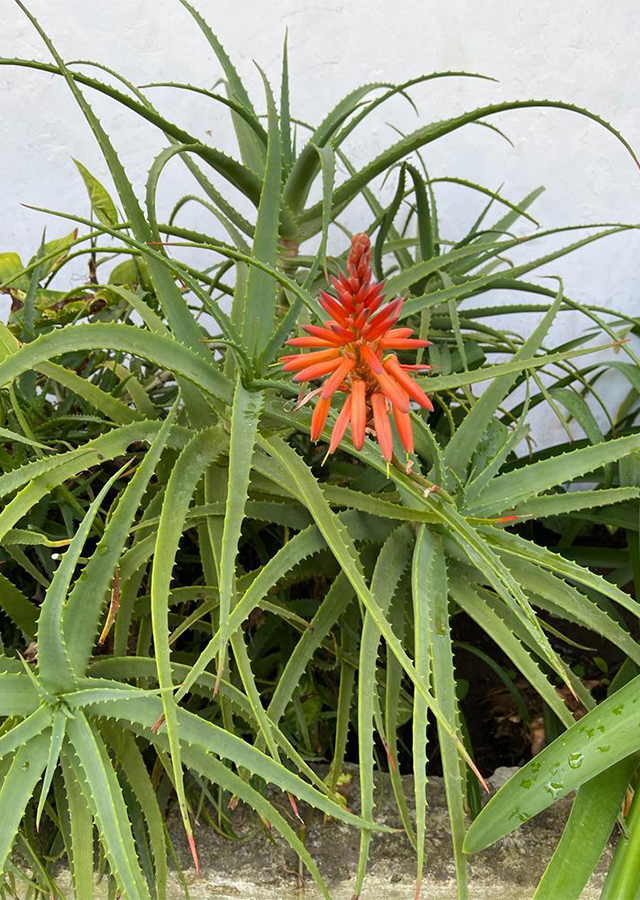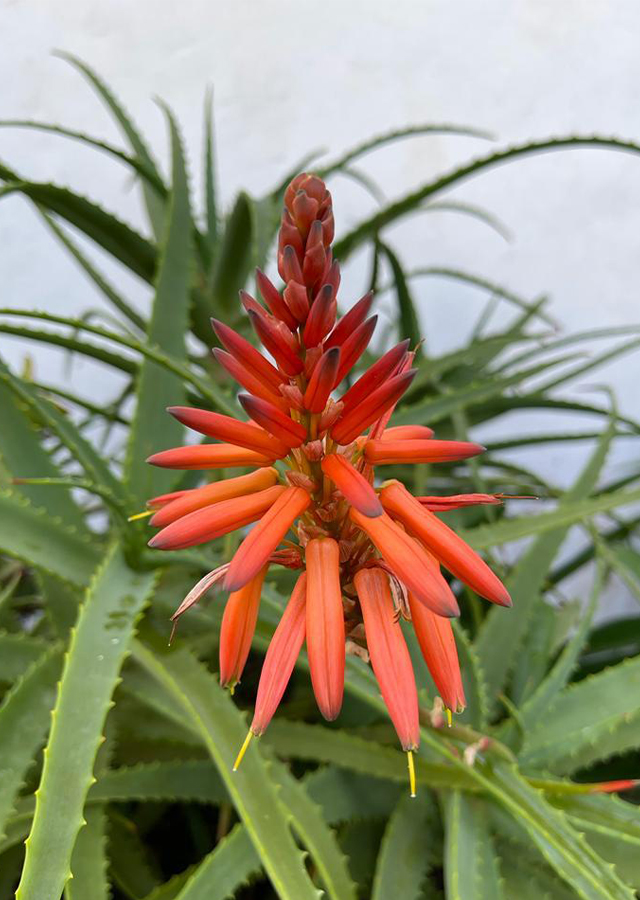Traditional Herbs from Aloe arborescens
burns
- Prepare fresh leaves of waxy aloe vera, wash them thoroughly.
- Cut or grind the leaves into a paste.
- Apply the leaf paste on even severe burns up to third degree burns.
constipation
- Prepare fresh leaves of waxy aloe vera, wash them thoroughly.
- Boil the leaves until soft.
- Eat leaves to treat constipation.
What is Aloe arborescens Looks like??



Parts of Aloe arborescens that could be used
- Leaf
- Sap
Aloe arborescens Distribution
Aloe arborescens is native to southern Africa and grows in Malawi, Botswana, Zimbabwe, and Mozambique as well as South Africa. This plant has been imported in many countries in tropical and subtropical areas as an ornamental and medicinal plant. In Italy it is grown commercially for medicinal and cosmetic use and in Japan for medicine and food. In Japan, where it was first introduced and naturalized in the 17th century. Aloe arborescens is an important ingredient in 'Kidachi aloe vera candy' which is popular in Japan for its sharp yoghurt taste. World attention was drawn to the possible value of a gel made from Aloe arborescens after the second World War, when burns on the skin of nuclear bomb victims in Japan were successfully treated with this gel. In southern Africa Aloe arborescens is planted as a living fence. Commercial growing of Aloe arborescens has begun recently in Israel and ChinaAgroecology of Aloe arborescens
Plants in semi-arid to humid tropical areas, found at altitudes up to 2,000 m above sea level. It grows best in areas where annual daytime temperatures are in the range of 18 - 26 °C, but can tolerate 9 - 38 °C. This species is intolerant of low temperatures (temperatures of -1 °C or lower). However, as long as the plant does not get wet, it can tolerate occasional temperatures down to around -4 °C. Its growth prefers average annual rainfall in the range of 400 - 1,500 mm, but tolerates 300 - 1,700 mm. Succeeds in full sun or light shade, requires well-drained, light to medium soil. Prefers a pH in the range of 5 - 6.5, tolerates 4.2 - 7. Established plants are drought tolerant.�
Morphology of Aloe arborescens
- Solitary stem, branched at or near base with persistent dead leaves.
- Leaves in rosette dense, spreading, become curved, stipules absent, petiole absent, lanceolate blade-like shape, measuring 60\u00a0\u00d7 7 cm, apex long tapered, margins firmly defined, deltoid, pointing forward, teeth yellow, length 4 mm, spacing 1-1.5 cm, blades greyish green, reddish tinge in dry conditions.
- Flowers bisexual, regular, 3-merous; stalk 1-1.5 cm long; perianth tubular, 3.5-4 cm long, 7 mm diameter, 6-lobed, free to base, bright orange to dark red, stamens 6, superior ovary, 3-celled, filiform style, stigma cephalic, exserted. Inflorescence in terminal cluster, 20-40 cm long. 1-4 per rosette, erect, cylindrical-acuminate, very densely flowered, peduncles up to 60 cm, simple or sparse with 1 short branch; bracts ovate, 2-5 mm long.
- Fruit capsule oblong-ovate to 18 \u00d7 7 mm, yellowish brown, divides loculicidally, many seeds.
- Seeds 3.5 mm long, with very narrow wings.
Cultivation of Aloe arborescens
- Aloe arborescens can be propagated by seeds and stem cuttings 3-10 cm long. It can also be done using the tissue culture method.
- Seeds: seeds are sown in sandy, well-drained potting soil in a warm, shady place in a standard seed tray. Germination takes about three weeks. Cover with a thin layer of sand (1-2 mm), keep moist and seedlings can be planted in individual bags or containers as soon as they are large enough to handle.
- Stem cuttings: length 3-10 cm. A branch or stem can be cut, left to dry for about a day until the wound closes, and then planted in well-drained soil or sand. It does not need to be rooted in any place and then transplanted, but can be placed directly in its permanent location in the garden. It is important to remember not to overwater the cutting. Overwatering can cause the plant to rot.
Aloe arborescens, more details :
Chemical Content of Aloe arborescensAnthrone 10-C-glucosides (anthraquinone derivatives) such as aloin and hydroxyaloin. Aloin is a mixture of the stereoisomers aloin A (barbaloin) and aloin B (isobarbaloin). The exudate contains free and glucosylated pyrone derivative aloenin and 2-acetonyl-7-hydroxy-5-methylchromone (e.g. aloesone, furoaloesone, aloeresin A, aloeresin B (aloesin) and aloeresin C). The gel contains polysaccharides and glycoproteins. In addition to mannan and glucomannan, arboran A and arboran B have been identified, which have hypoglycemic effects. The leaf epidermis contains lectins (alloctin A and alloctin B).
Benefits of Aloe arborescens
Treats burns and wounds, facilitates childbirth, can overcome constipation, accelerates gastric secretions, acts as a laxative, and is for dermatological use.
Simplisia of Aloe arborescens
Another Facts for Aloe arborescens :
Synonym of Aloe arborescensAloe perfoliata var. arborescens (Mill.) Aiton, Catevala arborescens (Mill.) Medik.
Habitus of Aloe arborescens
Succulents. Succulent plant reaches 5 m in height
Habitat of Aloe arborescens
- Forest
- Mountains
- Grassland



No comments:
Post a Comment